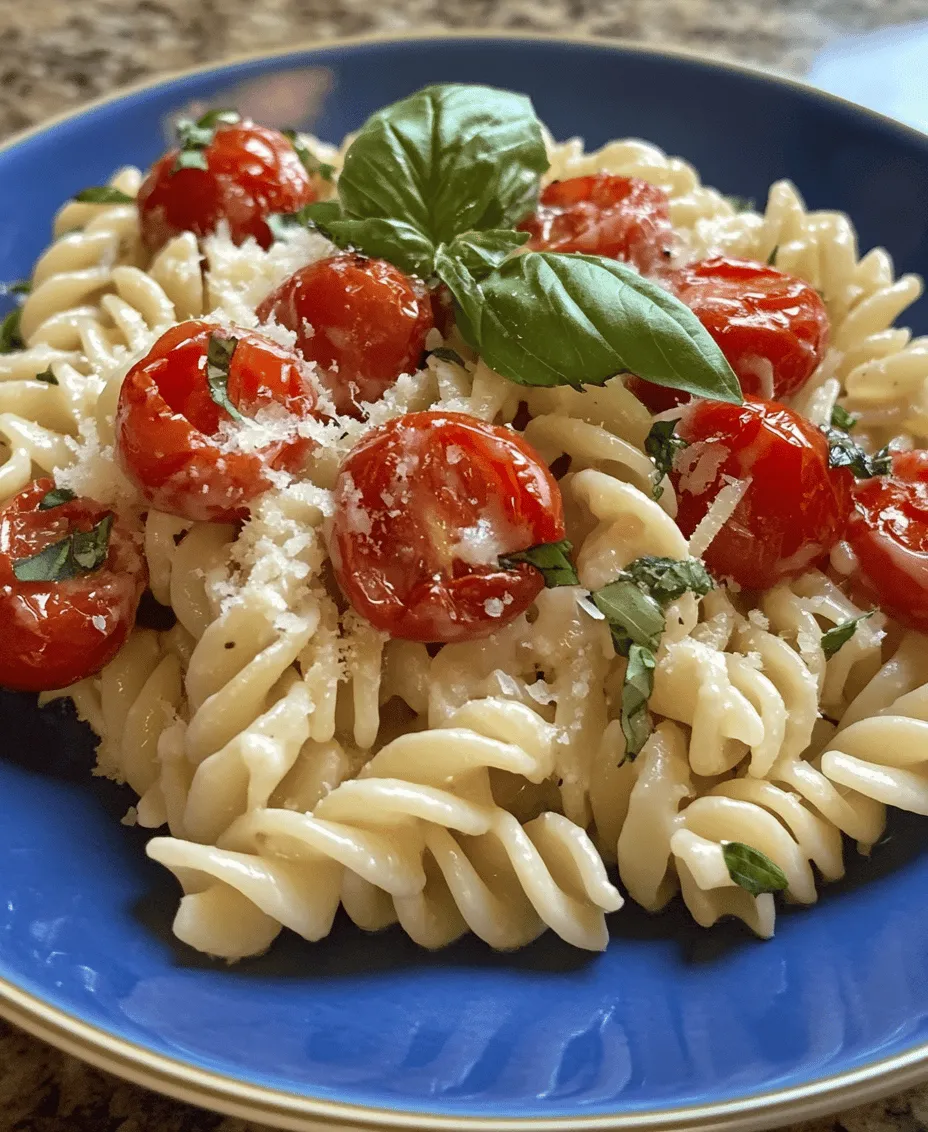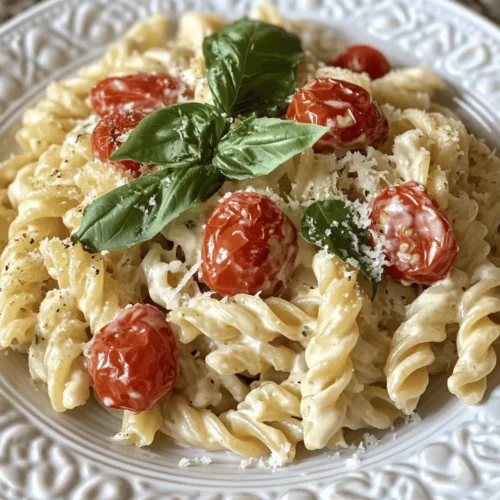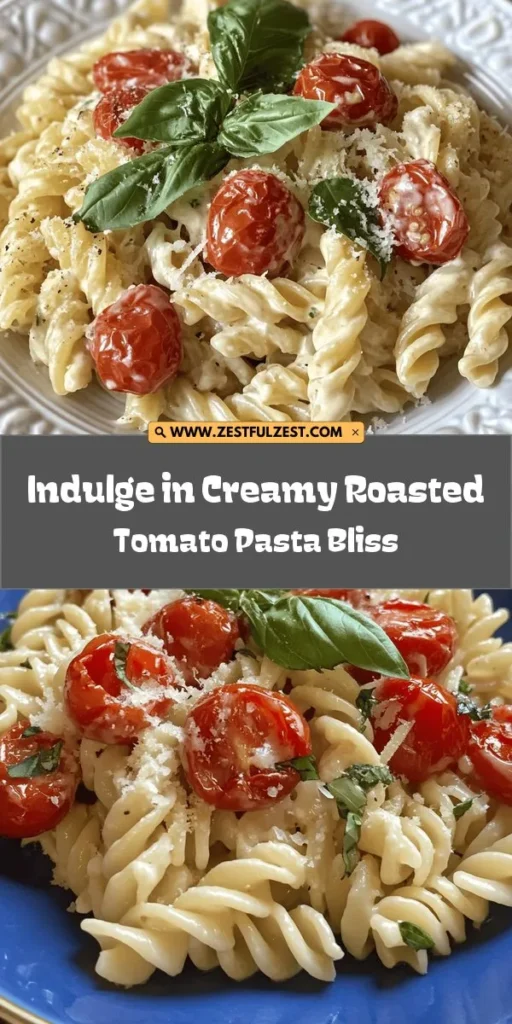Introduction
Creamy Roasted Tomato Pasta is not just a meal; it’s an experience that brings the essence of summer to your dining table, regardless of the season. This dish showcases the vibrant flavors and natural sweetness of roasted tomatoes, perfectly complemented by a creamy sauce that clings to each strand of pasta. It’s a comforting yet elegant recipe that appeals to both the novice cook and the seasoned chef, making it an excellent choice for family dinners, gatherings, or a cozy night in.
The appeal of this dish lies in its simplicity and the use of fresh, high-quality ingredients. When you roast tomatoes, their sugars caramelize, intensifying their flavor and creating a rich, savory base for the sauce. The addition of fresh herbs brings brightness and complexity, transforming an ordinary pasta dish into something extraordinary. Plus, it’s a versatile recipe; whether you’re vegan, vegetarian, or a meat lover, you can easily adapt it to suit your dietary preferences.
Understanding the Ingredients
Overview of Key Ingredients
To make Creamy Roasted Tomato Pasta, you need a handful of key ingredients. The primary components include ripe tomatoes, fresh herbs, pasta, garlic, cream (or a plant-based alternative), and cheese (if desired). Each ingredient plays a vital role in creating a harmonious blend of flavors.
– Tomatoes: The star of the dish, tomatoes provide a rich, tangy base that becomes even more flavorful when roasted.
– Fresh Herbs: Basil is commonly used, but you can also experiment with herbs like thyme or oregano to add depth.
– Pasta: Any type of pasta can work, but options like penne, fusilli, or spaghetti are particularly good at holding onto the creamy sauce.
– Garlic: This aromatic ingredient adds a layer of warmth and complexity to the dish.
– Cream: This adds a luscious texture and richness, balancing the acidity of the tomatoes.
The Health Benefits of Tomatoes
Tomatoes are not only delicious but also packed with nutrients. They are an excellent source of vitamins C and K, potassium, and folate. Additionally, tomatoes are rich in lycopene, a powerful antioxidant associated with numerous health benefits, including reduced risk of heart disease and cancer. The process of roasting tomatoes enhances their nutritional profile, making them easier for the body to absorb these beneficial compounds.
Importance of Fresh Herbs
Fresh herbs are essential for elevating the flavors in any dish, and this pasta recipe is no exception. Herbs like basil and parsley not only add a burst of freshness but also contribute essential oils and antioxidants, enhancing both the taste and health benefits of your meal. Using fresh herbs is key to achieving a vibrant flavor profile, so opting for fresh over dried is highly recommended.
Discussion on Different Types of Pasta
The type of pasta you choose can significantly affect the final dish. While traditional choices like spaghetti or fettuccine are always crowd-pleasers, using shapes like penne or rigatoni allows for more sauce to cling to the pasta, creating a more flavorful bite. Whole grain or gluten-free pasta can also be substituted for a healthier or dietary-specific option.
Preparing for the Recipe
Essential Kitchen Tools and Equipment Needed
Before embarking on your culinary adventure, ensure you have the following essential kitchen tools:
– Baking Sheet: For roasting the tomatoes, a large baking sheet will allow for proper heat circulation.
– Mixing Bowl: Use this for combining the ingredients before roasting.
– Pasta Pot: A large pot is necessary for boiling your pasta.
– Colander: To drain the pasta once it’s cooked.
– Blender or Food Processor: Optional, but great for creating a smooth sauce if desired.
– Chef’s Knife and Cutting Board: For chopping herbs and garlic.
Tips on Selecting Quality Tomatoes and Herbs
The quality of your ingredients will directly impact the flavor of your Creamy Roasted Tomato Pasta. Here are some tips for selecting the best tomatoes and herbs:
– Tomatoes: Look for tomatoes that are firm, with a vibrant color and no blemishes or soft spots. Varieties like Roma or heirloom tomatoes are excellent for roasting due to their thick flesh and rich flavor.
– Herbs: Fresh herbs should be fragrant and bright in color. Avoid wilted or discolored leaves, as they indicate age and diminished flavor.
Importance of Measuring Ingredients for Precision
While cooking can often be an art, precision is crucial, especially in recipes where the balance of flavors is key. Measuring ingredients—whether it’s the amount of cream or the quantity of herbs—ensures consistency and helps replicate the dish with the same delicious results every time. Consider using measuring cups and spoons for dry and liquid ingredients, and a kitchen scale for accuracy, especially with pasta.
Step-by-Step Instructions for Creamy Roasted Tomato Pasta
Preheating the Oven
Before you begin preparing your pasta, it’s essential to preheat your oven. Set the temperature to 400°F (200°C). This step is crucial for achieving perfectly roasted tomatoes. Preheating the oven ensures that the tomatoes cook evenly and develop a beautifully caramelized exterior.
Importance of Temperature Control for Roasting
Proper temperature control is vital when roasting tomatoes. Too low of a temperature will result in steaming rather than roasting, which means you won’t achieve that deep, rich flavor. Conversely, too high a temperature can cause the tomatoes to burn rather than caramelize. The ideal temperature allows for even cooking, enhancing the natural sweetness and flavor of the tomatoes while achieving a lovely texture.
Roasting the Tomatoes
Now that your oven is preheated, it’s time to roast the tomatoes. Start by washing your tomatoes thoroughly. Then, cut them in half and place them cut-side up on the baking sheet. Drizzle with olive oil, sprinkle with salt and pepper, and add minced garlic cloves. Toss everything together to ensure the tomatoes are well coated.
Detailed Explanation of the Roasting Process
Roasting tomatoes typically takes about 25 to 30 minutes. You’ll know they’re done when they are tender and slightly caramelized, with their skins beginning to blister. This roasting process not only intensifies the flavor but also enhances the texture, transforming the tomatoes into a rich, savory base for your pasta.
Benefits of Roasting: Flavor Intensification and Texture
Roasting tomatoes allows their natural sugars to caramelize, bringing out a depth of flavor that raw tomatoes simply cannot match. The result is a sweet yet savory sauce that forms the foundation of your creamy pasta. Additionally, roasting helps to concentrate the flavors while providing a delightful texture that contrasts beautifully with the creaminess of the sauce. The skins will slightly char and peel away, adding a rustic element to the dish.
With the tomatoes roasting to perfection, you’re well on your way to creating a delicious Creamy Roasted Tomato Pasta that will impress everyone at your table. Stay tuned for the next steps, where we’ll dive into combining the roasted tomatoes with pasta and cream to create a truly unforgettable meal.

Cooking the Pasta
Cooking pasta is an essential step in achieving a delicious Creamy Roasted Tomato Pasta. To ensure your pasta reaches the perfect al dente texture, start by filling a large pot with water. Use approximately 4-6 quarts of water for every pound of pasta. Bring the water to a rolling boil, then add a generous amount of salt—about 1-2 tablespoons. The salt not only enhances the flavor of the pasta but also helps to season it as it cooks.
Overview of Pasta Cooking Techniques for Perfect Al Dente
To achieve that ideal al dente texture, it’s crucial to follow the cooking time indicated on the pasta package. Check the pasta a minute or two before the suggested cooking time is up. Al dente pasta should be tender but firm to the bite. To test, simply take a piece out, let it cool for a moment, and taste it. If it’s done to your liking, drain it immediately. If it’s still too firm, give it a minute longer.
Importance of Reserving Pasta Water for Sauce Consistency
Before draining the pasta, be sure to reserve about a cup of the cooking water. This starchy water will be your secret weapon in creating a smooth, creamy sauce. The starch in the water helps to bind the sauce to the pasta, enhancing its overall texture and flavor. Once drained, you can set the pasta aside while you prepare the creamy sauce.
Creating the Creamy Sauce
Now that your pasta is ready, it’s time to create the creamy sauce that will elevate your roasted tomato dish.
Combining Roasted Tomatoes with Cream: Texture and Flavor Dynamics
In a large skillet over medium heat, add a splash of olive oil. Once hot, pour in the roasted tomatoes you prepared earlier. The sweetness of the roasted tomatoes combined with the richness of cream creates a delightful balance. Allow the tomatoes to simmer for a few minutes, letting their juices mingle with the oil and begin to caramelize slightly. Then, introduce the heavy cream (or a plant-based alternative if desired) into the skillet. Stir to combine, allowing the cream to heat through and create a luscious sauce.
Adjusting Sauce Consistency with Reserved Pasta Water
As the sauce heats up, it’s time to adjust its consistency. If the sauce appears too thick, gradually add the reserved pasta water, stirring continuously until you achieve your desired texture. The sauce should be creamy and cling to the pasta without being overly runny. Taste and adjust the seasoning as needed, adding salt, pepper, or even a pinch of red pepper flakes for a kick.
Bringing it All Together
With your pasta cooked and your creamy sauce ready, it’s time to bring the dish together for a delightful finale.
Tossing Pasta with Sauce: Techniques for Even Coating
Add the drained pasta to the skillet with the creamy roasted tomato sauce. Use tongs or a pasta fork to gently toss the pasta in the sauce. This technique ensures that every strand is evenly coated. If the sauce seems scant, don’t hesitate to add a bit more reserved pasta water to ensure thorough coverage.
Final Touches: Cheese Integration and Seasoning Adjustments
For those who enjoy cheese, now is the moment to add it. Grate fresh Parmesan or Pecorino Romano cheese over the pasta, stirring gently to incorporate. The heat from the pasta will help melt the cheese, adding an extra layer of creaminess. Taste the dish one last time, adjusting the seasoning with additional salt, pepper, or fresh herbs like basil or parsley as desired.
Serving Suggestions
Presenting your Creamy Roasted Tomato Pasta can enhance the dining experience, making it visually appealing and more enjoyable.
Ideal Serving Size and Presentation Tips
Typically, a serving size for pasta is about 2 ounces dry per person, which equates to roughly 1 cup of cooked pasta. For a beautiful presentation, twirl the pasta into nests using a fork or tongs and place them in the center of a shallow bowl or plate. Drizzle a bit of the creamy sauce around the edges, and sprinkle with fresh basil and more cheese for an inviting finish.
Pairing Options with Side Dishes and Beverages
To complement your pasta dish, consider serving a simple side salad with a light vinaigrette to balance the creaminess. Garlic bread or a crusty baguette works wonderfully to mop up any leftover sauce. For beverages, a chilled glass of white wine, such as Sauvignon Blanc or a light Pinot Grigio, pairs beautifully with the flavors of the roasted tomatoes and cream.
Variations: Customizing the Recipe with Other Ingredients
While the Creamy Roasted Tomato Pasta is delightful as is, feel free to customize it further. Add sautéed spinach or kale for added greens, or toss in some cooked chicken or shrimp for protein. For a vegan version, substitute the heavy cream with coconut cream and use nutritional yeast in place of cheese, ensuring everyone can enjoy the dish.
Nutritional Information
Understanding the nutritional content of your meal is essential, especially if you’re mindful of dietary needs.
Breakdown of Calories and Macronutrients Per Serving
A typical serving of Creamy Roasted Tomato Pasta contains approximately 450-600 calories, depending on the ingredients used. The macronutrient breakdown generally includes:
– Carbohydrates: 70g
– Protein: 10g
– Fat: 18g
These values can vary based on the choice of pasta and whether you add cheese or additional proteins.
Discussion on Dietary Adjustments (e.g., Vegan Alternatives)
For those following a vegan or dairy-free lifestyle, there are numerous alternatives available. Using gluten-free pasta can accommodate those with gluten sensitivities, while opting for plant-based cream and cheese substitutes can ensure that this dish fits within a vegan diet. Additionally, incorporating more vegetables can boost fiber content, making the dish even healthier.
Conclusion
Creamy Roasted Tomato Pasta is not only a delightful dish to prepare but also a comforting meal that brings joy to the table. Its rich flavors, combined with the ease of preparation, make it a perfect choice for weeknight dinners or special occasions alike.
We encourage you to experiment with the recipe, adding your personal touch through different ingredients or variations. Cooking is a creative process, and there’s nothing more rewarding than sharing a homemade meal with loved ones. So gather your ingredients, embrace the joy of cooking, and enjoy the delicious results of your efforts.



